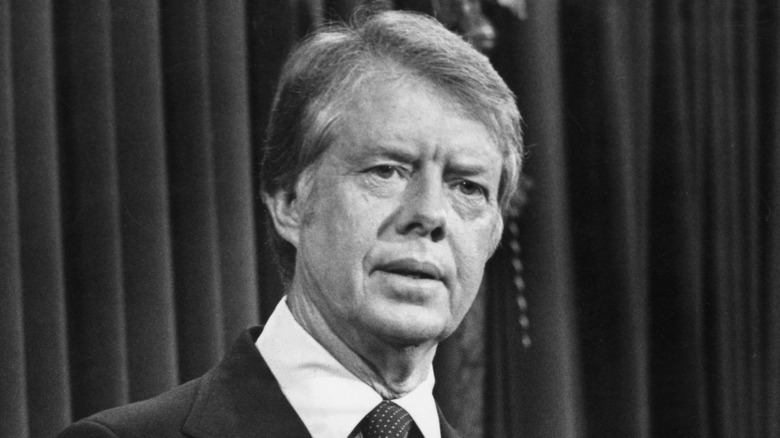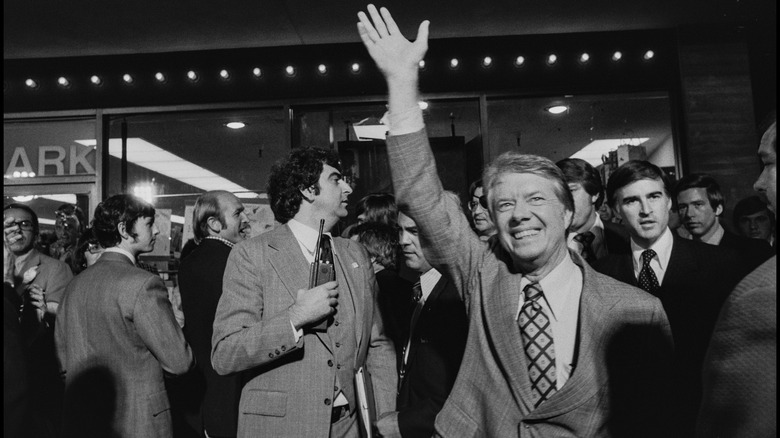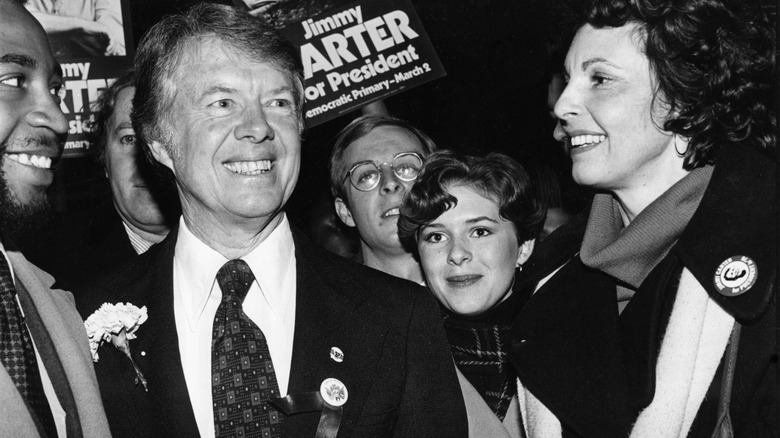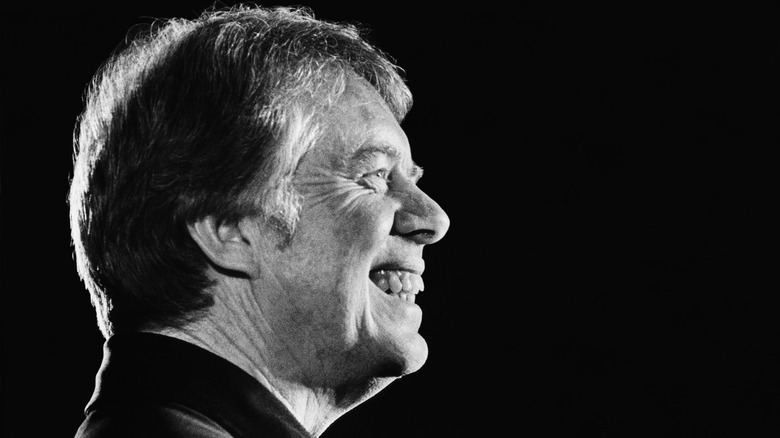Was There An Assassination Attempt Against Jimmy Carter?
Presidential assassination plots have claimed the lives of four out of 45 presidents in American history: Abraham Lincoln (1865), James A. Garfield (1881), William McKinley (1901), and John F. Kennedy (1963). Dozens of other presidential assassination attempts have been unsuccessful, thanks to heroic individuals, a diligent Secret Service agent, and unskilled gun handlers. President Jimmy Carter was the target of just one known assassination plot in the course of his single term (1977-81) in the White House, but it was a bizarre scheme that put conspiracy theorists on high alert.
In 1979, Carter delivered a speech at a Cinco de Mayo festival in Los Angeles at the Civic Center Mall. But just 10 minutes before the president took the stage, Secret Service agents noticed 35-year-old Raymond Lee Harvey, an unemployed drifter from Ohio, "looking nervous" as he stood 50 feet away from the president, per History on the Net. They detained and searched him, and found a .22 caliber eight-shot starter pistol, a prop pistol that simulates the sound and appearance of an actual revolver but doesn't fire any projectiles. And indeed, Harvey had a full 70 rounds of blanks on him, as well.
But why approach President Carter with a fake gun? Harvey, as it turns out, claimed to be working with three other conspirators, including two assassins. He would be the diversion, raising his starter pistol in the air and firing off several rounds, while the real assassins opened fire from a nearby building.
Alleged Mexican hitmen in a nearby building
By any rational measure it seems unlikely that a diversion from one fake firearm would make it easier for other, far-away assassins to shoot President Carter. After all, the second that Raymond Lee Harvey pulled out his pistol the crowd and fired off several loud, popping shots, everyone would erupt in panic and Secret Service would ferry President Carter away. It would be vastly harder for a sniper to shoot the president at that time rather than taking a single, clean shot while everyone was calm and stationary. Nonetheless, police followed up on Harvey's claims, and in so doing stumbled into a story that got more bizarre the further it progressed.
As the book "Hunting the President" says, Harvey claimed to be working with three co-conspirators, including two Mexican hitmen who would shoot the president with "high-powered rifles." While police didn't find any sniper rifles in nearby buildings, The Washington Post says that they found an empty shotgun case and three live shotgun rounds in the hotel room where the assassination plot supposedly took place. This lent some credence to Harvey's tale, and the police took one man into custody, 21-year-old Osvaldo Espinoza Ortiz. Ortiz was held on a $100,000 bond as a material witness, while Harvey was held at $50,000. History on the Net reports that Ortiz denied knowing Harvey at first, but later said he and Harvey tested the starter gun on the hotel's rooftop the night before Carter passed through.
A bizarre, conspiratorial name game
By the time Raymond Lee Harvey implicated Osvaldo Espinoza Ortiz in the alleged assassination plot against President Jimmy Carter, a lot of things didn't add up. The Washington Post describes Harvey as a drunk "transient" with a "history of mental illness," which prompts the question: How did he have the money and resources to hire assassins to collaborate in a plot to murder someone as high-ranking as the President of the United States?
As unlikely as the entire story was, it turned even weirder when folks noticed the oddities of Harvey's and Ortiz's names. Raymond Lee Harvey shared two names with Lee Harvey Oswald, the man who assassinated President John F. Kennedy in 1963. Furthermore, Osvaldo Espinoza Ortiz's first name — Osvaldo — is Spanish for Oswald. Put together, Harvey and Ortiz's names looked like some kind of crude anagram that created the name Lee Harvey Oswald.
As The Washington Post describes, this odd coincidence wasn't lost to the authorities or conspiracy theorists alike. However, there was no telling whether or not "Osvaldo Espinoza Ortiz" was the alleged gunman's actual name. FBI agents were, however, able to confirm that two other Mexican individuals — making four conspirators total, as Harvey had alleged — lived at the hotel where the assassination plot apparently took form, as The New York Times reported. Ortiz knew one of them, Umberto Camacho, but both Camacho and the other Mexican resident checked out the day that President Carter visited.
A false plot and no assassination attempt
In the end, there was no assassination plot against President Carter at all. The book "Hunting the Presidents" quotes FBI agent Tom Shield as saying, "We conducted an investigation and have satisfied ourselves that such [a plot] did not occur." Secret Service agent Jack Warner supported this conclusion, chiming in, "At this point we don't believe his [Raymond Lee Harvey's] story. Our investigation shows no evidence of a conspiracy. It sounds like the type of thing we get all the time." And so Harvey, the shotgun case and three shells in the hotel room, stories of rooftop snipers and starter pistol distractions, and weird name linkages between people involved: none of it was connected or meant anything whatsoever.
So why did Harvey paint a portrait of himself as a co-conspirator to assassinate the president? Maybe his own name inspired him. Coupled with his history of mental health issues, this might have been enough to drive him to self-destructive behavior. "Hunting the Presidents" also describes how some people target presidents for assassination out of nothing more complex than a vie to become famous.
A year after this 1979 non-spiracy, Carter had an eerie, quiet brush with a man who would actually try to end another president's life. While on his failed re-election campaign, Carter came within feet of John Hinckley Jr., per Dayton Daily News, who would later attempt to assassinate President Ronald Reagan. Hinckley apparently considered shooting Carter but backed out.



